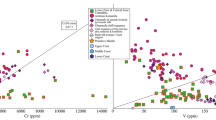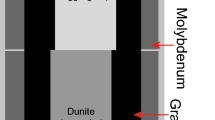Abstract
Previous models of degassing, cooling and compaction of rhyolitic ash flow deposits are combined in a single computational model that runs on a personal computer. The model applies to a broader range of initial and boundary conditions than Riehle's earlier model, which did not integrate heat and mass flux with compaction and which for compound units was limited to two deposits. Model temperatures and gas pressures compare well with simple measured examples. The results indicate that degassing of volatiles present at deposition occurs within days to a few weeks. Compaction occurs for weeks to two to three years unless halted by devitrification; near-emplacement temperatures can persist for tens of years in the interiors of thick deposits. Even modest rainfall significantly chills the upper parts of ash deposits, but compaction in simple cooling units ends before chilling by rainwater influences cooling of the interior of the sheet. Rainfall does, however, affect compaction at the boundaries of deposits in compound cooling units, because the influx of heat from the overlying unit is inadequate to overcome heat previously lost to vaporization of water. Three density profiles from the Matahina Ignimbrite, a compound cooling unit, are fairly well reproduced by the model despite complexities arising from numerous cooling breaks. Uncertainties in attempts to correlate in detail among the profiles may be the result of the non-uniform distribution of individual deposits. Regardless, it is inferred that model compaction is approximately valid. Thus the model should be of use in reconstructing the emplacement history of compound ash deposits, for inferring the depositional environments of ancient deposits and for assessing how long deposits of modern ash flows are capable of generating phreatic eruptions or secondary ash flows.
Similar content being viewed by others
References
Anderson T, Flett JS (1903) Report on the eruptions of the Soufriere in St. Vincent, and of a visit to Montagne Pelee in Martinique. Roy Soc London Proc 70:423–455
Bailey RA (1965) Field and petrographic notes on the Matahina Ignimbrite. In: Thompson BN et al. (eds) New Zealand Volcanology, Central Volcanic Region. N Z DSIR Information Ser 50:125–128
Bailey RA, Carr RG (1994) Physical geology and eruptive history of the Matahina Ignimbrite, Taupo Volcanic Zone, North Island, New Zealand. N Z J Geol Geophys 37:319–344
Bailey RA, Smith RL (1978) Volcanic geology of the Jemez Mountains, New Mexico. In: Hawley JW (ed) Guidebook to Rio Grande Rift in New Mexico and Colorado. New Mexico State Bureau of Mines and Mineral Resources Circ 163:184–196
Bierwirth PN (1982) Experimental welding of volcanic ash. BSc Thesis, Monash Univ. Cited in: Cas RAF, Wright JV (1986) Volcanic Successions, Modern and Ancient. Allen and Unwin, London, pp 256–258
Birch AF, Clark H (1940) The thermal conductivity of rocks and its dependence on temperature and composition. Am J Sci 238:613–635
Boow J, Turner WES (1942) The viscosity and working characteristics of glasses: part I. The viscosity of some commercial glasses at temperatures between approximately 500° and 1400°. Soc Glass Technol J 26:215–240
Bottinga Yan, Weill DF (1972) The viscosity of magmatic silicate liquids: a model for calculation. Am J Sci 272:438–475
Carr RG (1984) The Matahina Ignimbrite, its evolution including its eruption and post-depositional changes. PhD Dissertation, Univ. Auckland, 175 pp
Carslaw HS, Jaeger JC (1959) Conduction of Heat in Solids. 2nd edn. Clarendon Press, Oxford, 510 pp
Fenner CN (1923) The origin and mode of emplacement of the great tuff deposit of the Valley of Ten Thousand Smokes. National Geographic Society, Cont Tech Pap Katmai Ser 1: 1–74
Fenner CN (1948) Incandescent tuff flows in southern Peru. Bull Geol Soc Am 59:879–893
Flint LE, Raythcon Services of Nevada, Flint AL (1990) Preliminary permeability and water-retention data for nonwelded and bedded tuff samples, Yucca Mountain area, Nye County, Nevada: US Geol Survey Open-File Rep 90-569:32pp
Friedman I, Long W, Smith RL (1963) Viscosity and water content of rhyolite glass. J Geophys Res 68:6523–6535
Gilbert CM (1938) Welded tuff in eastern California. Bull Geol Soc Am 49:1829–1861
Griggs RF (1922) The Valley of Ten Thousand Smokes. National Geographic Society, Washington DC, 341 pp
Guest JE, Rogers PS (1967) The sintering of glass and its relationship to welding in ignimbrites. Proc Geol Soc London 1641:174–177
Iddings JP (1909) Igneous Rocks 1. Wiley, New York, 464 pp
Issa RI (1985) Solution of the implicitly discretized fluid flow equation by operator splitting. J Comput Phys 62:40–65
Kamata H, Johnston DA, Waitt RB (1991) Stratigraphy, chronology, and character of the 1976 pyroclastic eruption of Augustine volcano, Alaska. Bull Volcanol 53:407–419
Keith TEC (1991) Fossil and active fumaroles in the 1912 eruptive deposits, Valley of Ten Thousand Smokes, Alaska. J Volcanol Geotherm Res. 45:227–254
Keller GV (1960) Physical properties of tuffs of the Oak Spring Formation, Nevada. US Geol Survey Prof Pap 400-B:396–400
Kienle J, Swanson SE (1980) Volcanic hazards from future eruptions of Augustine volcano. Alaska. Rep UAG R-275, Univ Alaska Geophys Inst, Fairbanks, 122 pp
Kirby JM (1985) Deaeration of powders in hoppers: a simple linear theory including filling. Powder Technol 44:67–75
Kono Y, Osima Y (1971) Numerical experiments on the welding processes in the pyroclastic flow deposits. Bull Volcanol Soc Jpn 16:1–14
Kuntz MA, Rowley PD, Macleod NS, Reynolds RL, McBroome LA, Kaplan AM, Lidke DJ (1981) Petrography and particlesize distribution of pyroclastic-flow, ash-cloud, and surge deposits. In: Lipman PW, Mullineaux DW (eds) The 1980 Eruptions of Mount St. Helens, Washington. US Geol Survey Prof Pap 1250:525–540
Lacroix A (1904) La Montagne Pelee et ses Eruptions. Paris, 662 pp
Lee DW, Kingery WD (1960) Radiation energy transfer and thermal conductivity of porous materials. Am Ceramic Soc J 43:594–607
Lofgren G (1970) Experimental devitrification rate of rhyolite glass. Bull Geol Soc Am 81:553–560
Marshall P (1931) Notes on some volcanic rocks of the North Island of New Zealand. N Z J Sci Technol 13:198–202
McTaggart KC (1960) The mobility of nuees ardentes. Am J Sci 258:369–382
Miller TF (1990) A numerical model of volatile behavior in nonwelded cooling pyroclastic deposits. J Geophys Res 95:19 349–19 364
Miller TF, Riehle JR (1994) A users manual for ashpac: a program for predicting cooling, outgassing, and compaction of pyroclastic deposits. Tech Rep TR94-14, Applied Research Lab, Penn State Univ, State College, 47 pp
Morey GW (1954) The Properties of Glass. Rheinholdt, New York, 591 pp
Murfitt PG, Bransby DL (1980) Deaeration of powders in hoppers. Powder Technol 27:149–162
Patankar SV (1978) Numerical Heat Transfer and Fluid Flow. McGraw Hill, New York, 197 pp
Perret FA (1935) The eruption of Mont Pelee 1929–1932. Carnegie Inst Washington Publ 458:126 pp
Peterson DW (1961) Flattening ratios of pumice fragments in an ash-flow sheet near Superior, Arizona. US Geol Survey Prof Pap 424-D:82–84
Peterson DW (1979) Significance of the flattening of pumice fragments in ash-flow tuffs. In: Chapin CE, Elston WE (eds) Ashflow Tuffs. Geol Soc Am Spec Pap 180:195–204
Ragan DM, Sheridan MF (1972) Compaction of the Bishop Tuff, California. Bull Geol Soc Am 83:95–106
Ratte JC, Steven TA (1967) Ash flows and related volcanic rocks associated with the Creede caldera, San Juan Mountains, Colorado. US Geol Survey Prof Pap 524-H:1–58
Reynolds DL (1954) Fluidization as a geological process, and its bearing on the problem of intrusive granites. Am J Sci 252:577–614
Richardson JF (1971) Incipient fluidization and particulate systems. In: Davidson JF, Harrison D (eds) Fluidization. Academic Press, London, pp 52–53
Riehle JR (1970) Theoretical compaction profiles in ash-flow tuffs. PhD Dissertation, Northwestern Univ, Evanston, 152 pp
Riehle JR (1973) Calculated compaction profiles of rhyolitic ashflow tuffs. Bull Geol Soc Am 84:2193–2216
Ross CS, Smith RL (1961) Ash-flow tuffs: their origin, geologic relations, and identification. US Geol Surv Prof Pap 366:77 pp
Rowley PD, Kuntz MA, Macleod NS (1981) Pyroclastic-flow deposits. In: Lipman PW, Mullineaux DW (eds) The 1980 eruptions of Mount St. Helens, Washington US Geol Surv Prof Pap 1250:489–505
Ryan MP, Banks NG, Hoblitt RP, Blevins JYK (1990) The in-situ thermal transport properties and the thermal structure of Mount St. Helens eruptive units. In: Ryan MP (ed) Magma Transport and Storage. Wiley, New York, pp 137–155
Schminke H-U, Swanson DL (1967) Laminar viscous flowage structures in ash-flow tuffs from Gran Canaria, Canary Islands. J Geol 75:641–664
Sheridan NT (1970) Fumarolic mounds and ridges of the Bishop Tuff, California Bull Geol Soc Am 81:851–868
Smith RL (1960a) Ash flows. Bull Geol Soc Am 71:795–842
Smith RL (1960b) Zones and zonal variations in welded ash flows. US Geol Survey Prof Pap 354-F:149–159
Soo SL (1967) Fluid Dynamics of Multiphase Systems. Blaisdell, Waltham, 524 pp
Takahashi T, Tanaka L, Itoshima A, Fan LT (1984) Performance of a rotating fluidized bed. J Chem Engin Jpn 17:333–336
Taylor NW, McNamara EP, Sherman J (1937) A study of the elastico-viscous properties of a soda-lime-silica glass at temperatures near the ‘transformation point’. Soc Glass Technol J 21:61–81
Torres R, Self S, Martinez M. Secondary pyroclastic flows from the 15 June 1991 ignimbrite of Mount Pinatubo. US Geol Survey Prof Pap, in press
Wilson CJN (1980) The role of fluidization in the emplacement of pyroclastic flows: an experimental approach. J Volcanol Geotherm Res 8:231–249
Wilson CJN (1983) The role of fluidization in the emplacement of pyroclastic flows, 2: experimental results and their interpretation. J Volcanol Geotherm Res 20:55–84
Winograd IJ (1971) Hydrogeology of ash flow tuff: a preliminary statement. Wat Resour Res 7:994–1004
Zirkel F (1876) Microscopical petrography. US Geol Explor 40th Parallel Rep (King) 6:297 pp
Author information
Authors and Affiliations
Rights and permissions
About this article
Cite this article
Riehle, J.R., Miller, T.F. & Bailey, R.A. Cooling, degassing and compaction of rhyolitic ash flow tuffs: a computational model. Bull Volcanol 57, 319–336 (1995). https://doi.org/10.1007/BF00301291
Received:
Accepted:
Issue Date:
DOI: https://doi.org/10.1007/BF00301291




